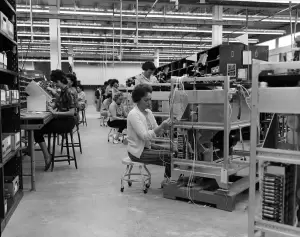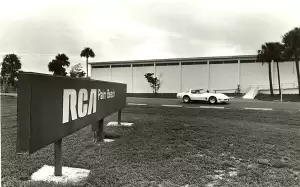Big Industry




Palm Beach County’s contributions during World War II brought more people to the county, and after the war, technology firms and defense contractors established offices and headquarters here. Firms like IBM, Pratt-Whitney, and RCA found that Florida’s climate and landscape suited their business. These firms soon became major employers, and communities like Palm Beach Gardens grew up around them.
Pratt & Whitney Aircraft, a division of United Aircraft, arrived first and built a 7,000-acre aircraft development laboratory and engine-testing facility northwest of West Palm Beach. They relocated most of the operation in 2000, retaining only their Space Propulsion Division and Sikorsky Aircraft.
It was 1960, and RCA was looking for a place to move from Moorestown, New Jersey. Bud Dickinson, who was a state senator, arranged for us to meet with the governor [Farris Bryant]. We went up in [MacArthur’s] Commander [airplane]… and Farris wrote a letter. He said, “I can’t make any promises, no concessions, no nothing, but we urge”—and MacArthur really dictated the letter. General [David] Sarnoff was chairman of the board of RCA and John Burns was his president, which is why it’s Burns Road, right there at RCA Boulevard. [The letter was] asking him to come to this area. Raleigh, North Carolina, sought them, and Dallas, Texas, sought them, and Palm Beach Gardens sought them. Well, MacArthur made concessions … and they moved, instead of [to] Dallas or Raleigh, to Palm Beach Gardens because of John D. MacArthur, in part because of Farris Bryant. [An] article in the Palm Beach Post mentions the individuals involved, including Governor Bryant, Senator Dickinson, John D., and others.
Frederick C. Prior
Although RCA announced its withdrawal from the general-purpose computer business in 1971, the company remained in Palm Beach Gardens with a reduced staff until 1986. Pratt & Whitney, which was expanding at the time, leased RCA’s excess space.
Minneapolis-Honeywell (now Honeywell, Inc.) operated a transistor manufacturing plant on Blue Heron Boulevard, Riviera Beach, from 1960 to 1965, when Solitron Devices purchased Honeywell’s plant. In 1993 Solitron moved to West Palm Beach, where it remains today.

South County
In 1966, before I-95 ran through southern Florida, IBM purchased 550 vacant acres northwest of Florida Atlantic University in Boca Raton. The company chose Boca Raton instead of California, said its chairman, because of the university, climate, orange juice, and Palm Beach International Airport. In 1967 the company opened its 620,000-square-foot facility there; in 1970 it dedicated the building.
Siemens Communications Systems moved from Cherry Hill, New Jersey, to Boca Raton in 1978, where it still maintains a major facility, including Nokia Siemens Networks US. In 1979 Motorola established its pager division headquarters in Boynton Beach, which it gradually downsized for several years before its final exit in 2004.
Sugar Production
From 1946 to 1961, regular rail ferry service operated between the U.S. and Cuba through the Port of Palm Beach and Fort Lauderdale’s Port Everglades. Fidel Castro took over Cuba in 1960, and trade ended between the two nations, including the import of Cuban sugar. (Then-U.S. Ambassador to Cuba Earl Edward Tailer Smith, unable to work with Castro, settled in Palm Beach, where he was mayor from 1971 to 1977).
Sugar policy has been addressed through legislation since 1789, the first U.S. Congress. In reaction to the loss of Cuban sugar, in 1962 Congress amended the then-current Sugar Act, removing quotas on U.S. sugar production; in Palm Beach County, it increased six-fold during the 1960s.
Cuban sugar producers whose property was seized by Castro started over in the U.S. These émigrés—such as Alfonso Fanjul Sr.—joined other Glades growers to form the Sugarcane Growers Cooperative of Florida. Today the Fanjul family has rebuilt a new sugar empire, Florida Crystals.
The Sugar Act was amended and expanded until it expired in 1974. Market prices were at a record high and Glades growers could expand as much as they wanted. Since then, the federal government has assisted producers with price supports and loan programs when prices have been low.


